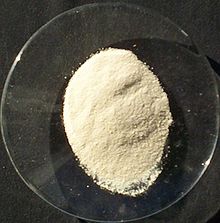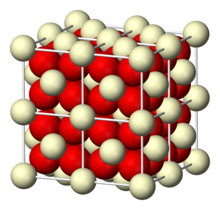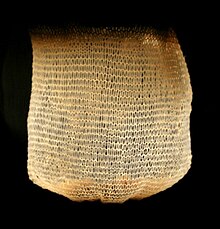
| |

| |
| Names | |
|---|---|
| IUPAC name Cerium(IV) oxide | |
| Other names
Ceric oxide, Ceria, Cerium dioxide | |
| Identifiers | |
| CAS Number |
|
| 3D model (JSmol) | |
| ChEBI | |
| ChemSpider | |
| ECHA InfoCard | 100.013.774 |
| PubChem CID | |
| UNII |
|
| CompTox Dashboard (EPA) | |
InChI
| |
SMILES
| |
| Properties | |
| Chemical formula | CeO2 |
| Molar mass | 172.115 g/mol |
| Appearance | white or pale yellow solid, slightly hygroscopic |
| Density | 7.215 g/cm |
| Melting point | 2,400 °C (4,350 °F; 2,670 K) |
| Boiling point | 3,500 °C (6,330 °F; 3,770 K) |
| Solubility in water | insoluble |
| Magnetic susceptibility (χ) | +26.0·10 cm/mol |
| Structure | |
| Crystal structure | cubic crystal system, cF12 (fluorite) |
| Space group | Fm3m, #225 |
| Lattice constant | a = 5.41 Å , b = 5.41 Å, c = 5.41 Åα = 90°, β = 90°, γ = 90° |
| Coordination geometry | Ce, 8, cubic O, 4, tetrahedral |
| Hazards | |
| NFPA 704 (fire diamond) |
 |
| Related compounds | |
| Related compounds | Cerium(III) oxide |
| Except where otherwise noted, data are given for materials in their standard state (at 25 °C , 100 kPa).
| |
Cerium(IV) oxide, also known as ceric oxide, ceric dioxide, ceria, cerium oxide or cerium dioxide, is an oxide of the rare-earth metal cerium. It is a pale yellow-white powder with the chemical formula CeO2. It is an important commercial product and an intermediate in the purification of the element from the ores. The distinctive property of this material is its reversible conversion to a non-stoichiometric oxide.
Production
Cerium occurs naturally as oxides, always as a mixture with other rare-earth elements. Its principal ores are bastnaesite and monazite. After extraction of the metal ions into aqueous base, Ce is separated from that mixture by addition of an oxidant followed by adjustment of the pH. This step exploits the low solubility of CeO2 and the fact that other rare-earth elements resist oxidation.
Cerium(IV) oxide is formed by the calcination of cerium oxalate or cerium hydroxide.
Cerium also forms cerium(III) oxide, Ce
2O
3, which is unstable and will oxidize to cerium(IV) oxide.
Characteristics
CeO2 is one of the most widely studied oxides of Cerium. CeO2 is the most-oxidized form of Cerium, 4f states strongly hybridizes with the O 2p states making 4f electrons delocalized. These states form a wide dispersive band, extending over a region of some eV, which can be correctly detected using theoretical methods accurately.
Structure and defect behavior
Cerium oxide adopts the fluorite structure, space group Fm3m, #225 containing 8-coordinate Ce and 4-coordinate O. At high temperatures it releases oxygen to give a non-stoichiometric, anion deficient form that retains the fluorite lattice. This material has the formula CeO(2−x), where 0 < x < 0.28. The value of x depends on both the temperature, surface termination and the oxygen partial pressure. The equation
has been shown to predict the equilibrium non-stoichiometry x over a wide range of oxygen partial pressures (10–10 Pa) and temperatures (1000–1900 °C).
The non-stoichiometric form has a blue to black color, and exhibits both ionic and electronic conduction with ionic being the most significant at temperatures > 500 °C.
The number of oxygen vacancies is frequently measured by using X-ray photoelectron spectroscopy to compare the ratio of Ce
to Ce
.
The loss of oxygen continues into the molten liquid state where the local Ce-O coordination number drops to predominantly 6-fold, compared to 8-fold in the stoichiometric fluorite structure. This has been shown to be directly analogous to plutonium oxides, once differences in oxygen potential are accounted for.
Defect chemistry
In the most stable fluorite phase of ceria, it exhibits several defects depending on partial pressure of oxygen or stress state of the material.
The primary defects of concern are oxygen vacancies and small polarons (electrons localized on cerium cations). Increasing the concentration of oxygen defects increases the diffusion rate of oxide anions in the lattice as reflected in an increase in ionic conductivity. These factors give ceria favorable performance in applications as a solid electrolyte in solid-oxide fuel cells. Undoped and doped ceria also exhibit high electronic conductivity at low partial pressures of oxygen due to reduction of the cerium ion leading to the formation of small polarons. Since the oxygen atoms in a ceria crystal occur in planes, diffusion of these anions is facile. The diffusion rate increases as the defect concentration increases.
The presence of oxygen vacancies at terminating ceria planes governs the energetics of ceria interactions with adsorbate molecules, and its wettability. Controlling such surface interactions is key to harnessing ceria in catalytic applications.
Natural occurrence
Cerium(IV) oxide occurs naturally as the mineral cerianite-(Ce). It is a rare example of tetravalent cerium mineral, the other examples being stetindite-(Ce) and dyrnaesite-(La). The "-(Ce)" suffix is known as Levinson modifier and is used to show which element dominates in a particular site in the structure. It is often found in names of minerals bearing rare earth elements (REEs). Occurrence of cerianite-(Ce) is related to some examples of cerium anomaly, where Ce - which is oxidized easily - is separated from other REEs that remain trivalent and thus fit to structures of other minerals than cerianite-(Ce).
Applications
Cerium has two main applications, which are listed below.
The principal industrial application of ceria is for polishing, especially chemical-mechanical planarization (CMP). For this purpose, it has displaced many other oxides that were previously used, such as iron oxide and zirconia. For hobbyists, it is also known as "opticians' rouge".
In its other main application, CeO2 is used to decolorize glass. It functions by converting green-tinted ferrous impurities to nearly colorless ferric oxides.
Other niche and emerging applications
Catalysis
CeO2 has attracted much attention in the area of heterogeneous catalysis. It catalyses the water-gas shift reaction. It oxidizes carbon monoxide. Its reduced derivative Ce2O3 reduces water, with release of hydrogen.
The interconvertibility of CeOx materials is the basis of the use of ceria for an oxidation catalyst. One small but illustrative use is its use in the walls of self-cleaning ovens as a hydrocarbon oxidation catalyst during the high-temperature cleaning process. Another small scale but famous example is its role in oxidation of natural gas in gas mantles.

Building on its distinct surface interactions, ceria finds further use as a sensor in catalytic converters in automotive applications, controlling the air-exhaust ratio to reduce NOx and carbon monoxide emissions.
Energy & fuels
Due to the significant ionic and electronic conduction of cerium oxide, it is well suited to be used as a mixed conductor. As such, cerium oxide is a material of interest for solid oxide fuel cells (SOFCs) in comparison to zirconium oxide.
Thermochemically, the cerium(IV) oxide–cerium(III) oxide cycle or CeO2/Ce2O3 cycle is a two-step water splitting process that has been used for hydrogen production. Because it leverages the oxygen vacancies between systems, this allows ceria in water to form hydroxyl (OH) groups. The hydroxyl groups can then be released as oxygen oxidizes, thus providing a source of clean energy.
Optics
Cerium oxide is highly valued in the optics industry for its exceptional polishing capabilities. It effectively removes minor scratches and imperfections from glass surfaces through both mechanical abrasion and chemical interaction, producing a smooth, high-gloss finish. Cerium oxide can also enhance the durability of optical surfaces by forming a protective layer that increases resistance to scratches and environmental wear.
Cerium oxide has also found use in infrared filters and as a replacement for thorium dioxide in incandescent mantles
Welding
Cerium oxide is used as an addition to tungsten electrodes for Gas Tungsten Arc Welding. It provides advantages over pure Tungsten electrodes such as reducing electrode consumption rate and easier arc starting & stability. Ceria electrodes were first introduced in the US market in 1987, and are useful in AC, DC Electrode Positive, and DC Electrode Negative.
Safety aspects
Cerium oxide nanoparticles (nanoceria) have been investigated for their antibacterial and antioxidant activity.
Nanoceria is a prospective replacement of zinc oxide and titanium dioxide in sunscreens, as it has lower photocatalytic activity.
See also
References
- Pradyot Patnaik. Handbook of Inorganic Chemicals. McGraw-Hill, 2002, ISBN 0-07-049439-8
- E. A. Kümmerle and G. Heger, “The Structures of C-Ce2O3+δ, Ce7O12, and Ce11O20,” Journal of Solid State Chemistry, vol. 147, no. 2, pp. 485–500, 1999.
- ^ Reinhardt, Klaus; Winkler, Herwig (2000). "Cerium Mischmetal, Cerium Alloys, and Cerium Compounds". Ullmann's Encyclopedia of Industrial Chemistry. Weinheim: Wiley-VCH. doi:10.1002/14356007.a06_139. ISBN 978-3527306732..
- "Standard Thermodynamic Properties of Chemical Substances" (PDF). Archived from the original (PDF) on October 29, 2013.
- Herper, Heike C; Vekilova, Olga Yu; Simak, Sergei I; Di Marco, Igor; Eriksson, Olle (2020-02-25). "Localized versus itinerant character of 4f-states in cerium oxides". Journal of Physics: Condensed Matter. 32 (21): 215502. doi:10.1088/1361-648x/ab6e92. ISSN 0953-8984.
- DFT study of Cerium Oxide Surfaces Applied surface science 2019 vol 478
- Defects and Defect Processes in Nonmetallic Solids By William Hayes, A. M. Stoneham Courier Dover Publications, 2004.
- Bulfin, B.; Lowe, A. J.; Keogh, K. A.; Murphy, B. E.; Lübben, O.; Krasnikov, S. A.; Shvets, I. V. (2013). "Analytical Model of CeO2 Oxidation and Reduction". The Journal of Physical Chemistry C. 117 (46): 24129–24137. doi:10.1021/jp406578z. hdl:2262/76279.
- Ghillanyova, K.; Galusek, D. (2011). "Chapter 1: Ceramic oxides". In Riedel, Ralf; Chen, I-Wie (eds.). Ceramics Science and Technology, Materials and Properties, vol 2. John Wiley & Sons. ISBN 978-3-527-31156-9.
- Wilke, Stephen; Benmore, Chris; Alderman, Oliver; Sivaraman, Ganesh; Ruehl, Matthew; Hawthorne, Krista; Tamalonis, Anthony; Andersson, David; Williamson, Mark; Weber, Richard (2024). "Plutonium oxide melt structure and covalency". Nature Materials. 23: 884–889. doi:10.1038/s41563-024-01883-3.
- Munnings, C.; Badwal, S.P.S.; Fini, D. (2014). "Spontaneous stress-induced oxidation of Ce ions in Gd-doped ceria at room temperature". Ionics. 20 (8): 1117–1126. doi:10.1007/s11581-014-1079-2. S2CID 95469920.
- Badwal, S.P.S.; Daniel Fini; Fabio Ciacchi; Christopher Munnings; Justin Kimpton; John Drennan (2013). "Structural and microstructural stability of ceria – gadolinia electrolyte exposed to reducing environments of high temperature fuel cells". J. Mater. Chem. A. 1 (36): 10768–10782. doi:10.1039/C3TA11752A.
- Anandkumar, Mariappan; Bhattacharya, Saswata; Deshpande, Atul Suresh (2019-08-23). "Low temperature synthesis and characterization of single phase multi-component fluorite oxide nanoparticle sols". RSC Advances. 9 (46): 26825–26830. Bibcode:2019RSCAd...926825A. doi:10.1039/C9RA04636D. ISSN 2046-2069. PMC 9070433. PMID 35528557.
- Pinto, Felipe M (2019). "Oxygen Defects and Surface Chemistry of Reducible Oxides". Frontiers in Materials. 6: 260. Bibcode:2019FrMat...6..260P. doi:10.3389/fmats.2019.00260. S2CID 204754299.
- Fronzi, Marco; Assadi, M. Hussein N.; Hanaor, Dorian A.H. (2019). "Theoretical insights into the hydrophobicity of low index CeO2 surfaces" (PDF). Applied Surface Science. 478: 68–74. arXiv:1902.02662. Bibcode:2019ApSS..478...68F. doi:10.1016/j.apsusc.2019.01.208. S2CID 118895100.
- ^ "Cerianite-(Ce)". www.mindat.org. Retrieved 2020-11-12.
- ^ "List of Minerals". www.ima-mineralogy.org. 2011-03-21. Retrieved 2020-11-12.
- Burke, Ernst (2008). "The use of suffixes in mineral names" (PDF). Elements. 4 (2): 96.
- Pan, Yuanming; Stauffer, Mel R. (2000). "Cerium anomaly and Th/U fractionation in the 1.85 Ga Flin Flon Paleosol: Clues from REE- and U-rich accessory minerals and implications for paleoatmospheric reconstruction". American Mineralogist. 85 (7): 898–911. Bibcode:2000AmMin..85..898P. doi:10.2138/am-2000-0703. S2CID 41920305.
- "Properties of Common Abrasives (Boston Museum of Fine Arts)" (PDF).
- "Ceric oxide - CAMEO". cameo.mfa.org.
- Ruosi Peng; et a. (2018). "Size effect of Pt nanoparticles on the catalytic oxidation of toluene over Pt/CeO2 catalysts". Applied Catalysis B: Environmental. 220: 462. Bibcode:2018AppCB.220..462P. doi:10.1016/j.apcatb.2017.07.048.
- Montini, Tiziano; Melchionna, Michele; Monai, Matteo; Fornasiero, Paolo (2016). "Fundamentals and Catalytic Applications of CeO2-Based Materials". Chemical Reviews. 116 (10): 5987–6041. doi:10.1021/acs.chemrev.5b00603. hdl:11368/2890051. PMID 27120134.
- Paier, Joachim; Penschke, Christopher; Sauer, Joachim (2013). "Oxygen Defects and Surface Chemistry of Ceria: Quantum Chemical Studies Compared to Experiment". Chemical Reviews. 113 (6): 3949–3985. doi:10.1021/cr3004949. PMID 23651311.
- Gorte, Raymond J. (2010). "Ceria in catalysis: From automotive applications to the water-gas shift reaction". AIChE Journal. 56 (5): 1126–1135. Bibcode:2010AIChE..56.1126G. doi:10.1002/aic.12234.
- Greenwood, Norman N.; Earnshaw, Alan (1997). Chemistry of the Elements (2nd ed.). Butterworth-Heinemann. ISBN 978-0-08-037941-8.
- Twigg, Martyn V. (2011). "Catalytic control of emissions from cars". Catalysis Today. 163: 33–41. doi:10.1016/j.cattod.2010.12.044.
- "Mixed conductors". Max Planck institute for solid state research. Retrieved 16 September 2016.
- Arachi, Y. (June 1999). "Electrical conductivity of the ZrO2–Ln2O3 (Ln=lanthanides) system". Solid State Ionics. 121 (1–4): 133–139. doi:10.1016/S0167-2738(98)00540-2.
- "Hydrogen production from solar thermochemical water splitting cycles". SolarPACES. Archived from the original on August 30, 2009.
- "New discoveries made on the role of Cerium Oxide in Hydrogen production". Ceric. 2018-07-01. Retrieved 2022-09-22.
- "Cerium Oxide in Removing Scratches from Phone Screens". Stanford Advanced Materials. Retrieved July 1, 2024.
- Janos, Pavel; Ederer, Jakub (2016). "Chemical mechanical glass polishing with cerium oxide: Effect of selected physico-chemical characteristics on polishing efficiency". Wear. 362–363: 114–120. doi:10.1016/j.wear.2016.05.020.
- Hockey, B.J.; Roy, Rice, eds. (1979). The science of ceramic machining and surface finishing II: Proceedings of a symposium held at the National Bureau of Standards, Gaithersburg, Maryland, November 13-15, 1978. University of Michigan Library. p. 425. ASIN B0030T20RY.
- "Cerium dioxide". DaNa. Archived from the original on 2013-03-02.
- Rajeshkumar, S.; Naik, Poonam (2018). "Synthesis and biomedical applications of Cerium oxide nanoparticles – A Review". Biotechnology Reports. 17: 1–5. doi:10.1016/j.btre.2017.11.008. ISSN 2215-017X. PMC 5723353. PMID 29234605.
- Karakoti, A. S.; Monteiro-Riviere, N. A.; Aggarwal, R.; Davis, J. P.; Narayan, R. J.; Self, W. T.; McGinnis, J.; Seal, S. (2008). "Nanoceria as antioxidant: synthesis and biomedical applications". JOM. 60 (3): 33–37. Bibcode:2008JOM....60c..33K. doi:10.1007/s11837-008-0029-8. PMC 2898180. PMID 20617106.
- Rajeshkumar, S.; Naik, Poonam (2017-11-29). "Synthesis and biomedical applications of Cerium oxide nanoparticles – A Review". Biotechnology Reports. 17: 1–5. doi:10.1016/j.btre.2017.11.008. ISSN 2215-017X. PMC 5723353. PMID 29234605.
- Hussain S, Al-Nsour F, Rice AB, Marshburn J, Yingling B, Ji Z, Zink JI, Walker NJ, Garantziotis S (2012). "Cerium dioxide nanoparticles induce apoptosis and autophagy in human peripheral blood monocytes". ACS Nano. 6 (7): 5820–9. doi:10.1021/nn302235u. PMC 4582414. PMID 22717232.
- Zholobak, N.M.; Ivanov, V.K.; Shcherbakov, A.B.; Shaporev, A.S.; Polezhaeva, O.S.; Baranchikov, A.Ye.; Spivak, N.Ya.; Tretyakov, Yu.D. (2011). "UV-shielding property, photocatalytic activity and photocytotoxicity of ceria colloid solutions". Journal of Photochemistry and Photobiology B: Biology. 102 (1): 32–38. Bibcode:2011JPPB..102...32Z. doi:10.1016/j.jphotobiol.2010.09.002. PMID 20926307.
External links
| Cerium compounds | |||
|---|---|---|---|
| Cerium(II) | |||
| Cerium(III) |
| ||
| Cerium(III,IV) | |||
| Cerium(IV) | |||
